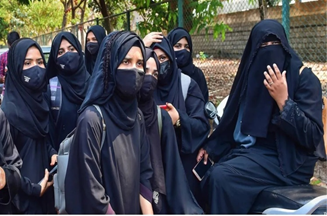

14th October 2022 (10 Topics)
Context
Recently, the Supreme Court has delivered a split verdict on whether Muslim Girls/ students should shed their hijabs at the Educational Institutions, again igniting the debate around the Right to profess and follow their religion.
About
-
- Over the years, the Supreme Court has evolved a practical test of sorts to determine. What religious practices can be constitutionally protected and what can be ignored.
What are Essential Acts?
- Origin of the Essential Practice Doctrine: The ‘essential practice’ doctrine can be traced to a 1954 decision of the Supreme Court, ‘Shirur Mutt’
- The SC, had held in the Shirur Mutt case that “In the first place, what constitutes the essential part of a religion is primarily to be ascertained with reference to the doctrines of that religion itself”.
- Hence, some acts obtained constitutional protection by being declared, “essential” to the practice of that religion. And some were denied protection on the ground that they were not essential to it.
Supreme Court’s (SC) Previous Judgements on Hijab Case:
- As per the SC, Wearing of hijab (head scarf) by Muslim women does not form a part of essential religious practices in Islamic faith. And it is not protected under the right to freedom of religion guaranteed under Article 25, of the Constitution of India.
- The court ruled that prescription of school uniform does not violate either the right to freedom of speech. And expression under Article 19(1) (a) or the right to privacy under Article 21 of the Constitution. And the restriction against wearing of hijab. In educational institutions is only a reasonable restriction constitutionally permissible, which the students cannot object to.
- The court upheld the legality of the Karnataka Government’s order prescribing wearing of uniforms in schools. And pre-university colleges under provisions of the Karnataka Education Act, 1983.
About Religious Freedom Protected under the Constitution: Article 25(1) of the Constitution guarantees. The “freedom of conscience and the right freely to profess, practise and propagate religion”. It is a right that guarantees a negative liberty — which means that the state shall ensure that. There is no interference or obstacle to exercise this freedom. However, like all fundamental rights. the state can restrict the right for grounds of public order, decency, morality, health and other state interests. What does the present SC bench said regarding the Hijab ban?
- The Two-Judge bench hearing the Hijab Case has shown splitting views over the issue.
- Justice Hemant Gupta, upheld Karnataka’s prohibitive government order, saying apparent symbols of religious belief cannot be worn to secular schools maintained from State funds.
- In his divergent opinion, Justice Sudhanshu Dhulia said secularity meant tolerance to “diversity”.
- Wearing or not wearing a hijab to school was “ultimately a matter of choice”.
- For girls from conservative families, “her hijab is her ticket to education”.
Key points of Consideration:
- Fundamental Rights of Girls/Students on wearing. whatever they want but conditional restrictions over educational Institutions.
- Conservative mind-set of parents/families for girl child to get education. It is a Human right. And cannot be seen as constraint under a practice of any religion.
- Judgements to be given for larger good and not only considering a group of people’s opinion.
|
Argument in Support of the Hijab Ban |
Argument against Hijab Ban |
|
|

